
The Teloschistaceae are a large family of mostly lichen-forming fungi belonging to the class Lecanoromycetes in the division Ascomycota. The family has a cosmopolitan distribution, although members occur predominantly in temperate regions. Most members are lichens that either live on rock or on bark, but about 40 species are lichenicolous – meaning they are non-lichenised fungi that live on other lichens. Many members of the Teloschistaceae are readily identifiable by their vibrant orange to yellow hue, a result of their frequent anthraquinone content. The presence of these anthraquinone pigments, which confer protection from ultraviolet light, enabled this group to expand from shaded forest habitats to harsher environmental conditions of sunny and arid ecosystems during the Late Cretaceous.

Rusavskia elegans, commonly known as the elegant sunburst lichen, is a lichenized species of fungus in the genus Rusavskia, family Teloschistaceae. Recognized by its bright orange or red pigmentation, this species grows on rocks, often near bird or rodent perches. It has a circumpolar and alpine distribution. It was one of the first lichens to be used for the rock-face dating method known as lichenometry.
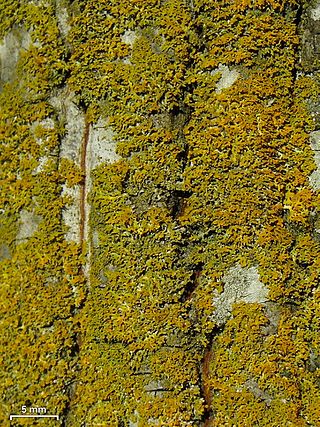
Gallowayella is a genus of lichen-forming fungi in the family Teloschistaceae. It has 15 species. The genus was circumscribed in 2012 by Sergey Kondratyuk, Natalya Fedorenko, Soili Stenroos, Ingvar Kärnefelt, Jack Elix, and Arne Thell, with Gallowayella coppinsii assigned as the type species. The generic name honours New Zealand lichenologist David John Galloway (1942–2014).
Gallowayella aphrodites is a species of corticolous (bark-dwelling), foliose (leafy) lichen in the family Teloschistaceae. It is found in the Mediterranean countries Greece, Cyprus, and Italy. Characteristics of the lichen include its small thallus, the disposition of the rhizines on the thallus undersurface, and the lack of vegetative propagules.
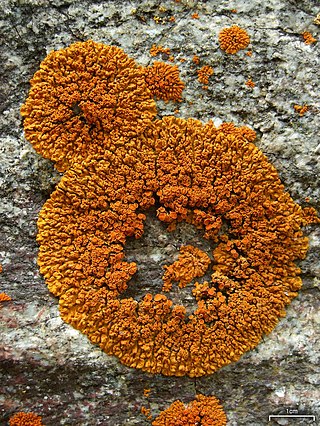
Golubkovia is a single-species fungal genus in the family Teloschistaceae. It contains the species Golubkovia trachyphylla, a rock-dwelling lichen that is found in Asia and North America. This crustose lichen has a yellow-orange thallus that is placodioid in form.

Wetmoreana is a genus of lichen-forming fungi in the family Teloschistaceae. It has two crustose, saxicolous (rock-dwelling) species.
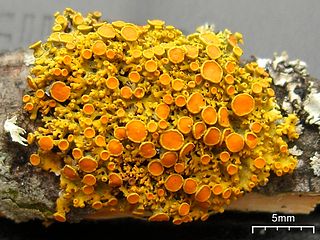
Gallowayella hasseana, the poplar sunburst lichen, is a species of corticolous (bark-dwelling), crustose lichen in the family Teloschistaceae. It occurs in North America.
Jackelixia whinrayi is a lichen in the family Teloschistaceae. It was first described in 2007 by Sergey Kondratyuk and Ingvar Kärnefelt as Xanthoria whinrayi, but was transferred to the genus Jackelixia in 2009 by Kondratyuk, Natalya M. Fedorenko, Soili Kristina Stenroos, Kärnefelt, and Arne Thell.
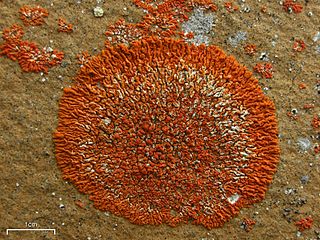
Rusavskia is a genus of lichen-forming fungi in the family Teloschistaceae. It has 12 species. It is a member of the subfamily Xanthorioideae. The thallus of Rusavskia is characterized by its foliose (leaf-like) structure with distinct and typically narrow lobes that curve outwards.

Martinjahnsia is a single-species fungal genus in the family Teloschistaceae. It contains the sole species Martinjahnsia resendei, a saxicolous (rock-dwelling) crustose lichen.

Niorma hosseusiana is a species of corticolous (bark-dwelling), fruticose lichen in the family Teloschistaceae. It is found in South America.
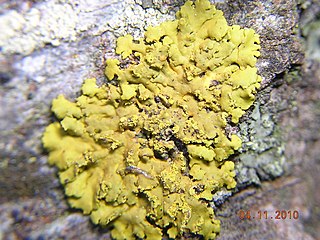
Gallowayella fulva is a species of foliose lichen in the family Teloschistaceae. It was first scientifically described in 1796 by German lichenologist Georg Franz Hoffmann, who classified it as a member of genus Lobaria. It has also been classified in the genera Oxneria, Xanthomendoza and Xanthoria in its taxonomic history. Sergey Kondratyuk and colleagues transferred the taxon to the genus Gallowayella in 2012, based on a molecular phylogenetics-based restructuring of some genera in the subfamily Xanthorioideae of family Teloschistaceae. In North America, one vernacular name for the species is the bare-bottomed sunburst lichen.
Xanthoria yorkensis is a species of corticolous (bark-dwelling), crustose lichen in the family Teloschistaceae. Found in South Australia, it was formally described as a new species in 2009 by lichenologists Sergey Kondratyuk and Ingvar Kärnefelt. The type specimen, collected along the Maitland road in Yorke Peninsula, was found growing on Melaleuca trees in mallee scrub. The species epithet refers to its type locality, the only place the lichen is known to occur. Kondratyuk and colleagues proposed to transfer the taxon to the newly circumscribed Jackelixia in 2009, but this genus has not been widely accepted by other authorities.
Xanthoria kangarooensis is a species of corticolous (bark-dwelling), crustose lichen in the family Teloschistaceae. Found in Australia, it was formally described as a new species in 2009 by lichenologists Sergey Kondratyuk and Ingvar Kärnefelt. The type specimen was collected from East Kangaroo Island, where it was found growing on dead Lycium ferocissimum shrubs. Other associated lichens include species of Pyxine, Ramalina, and Rinodina. The species epithet kangarooensis refers to its type locality, the only place the lichen is known to occur. Kondratyuk and colleagues proposed to transfer the taxon to the newly circumscribed Jackelixia in 2009, but this genus has not been widely accepted by other authorities.
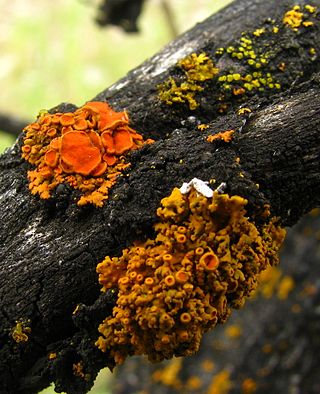
Gallowayella montana is a species of corticolous (bark-dwelling) lichen in the family Teloschistaceae. It occurs in North America.

Gallowayella weberi is a species of corticolous and saxicolous, foliose lichen in the family Teloschistaceae. Found in the eastern United States, it is a small lichen with a smooth yellow to orange upper surface and a contrasting white lower surface.

Xanthomendoza oregana is a species of corticolous (bark-dwelling), foliose lichen in the family Teloschistaceae. It forms an orange to bright-yellow thallus with ascending lobes that gives it the overall appearance of a tuft. The lichen occurs in western Europe and western North America.
Honeggeria is a single-species fungal genus in the family Teloschistaceae. It contains the species Honeggeria rosmarieae, a corticolous (bark-dwelling), foliose lichen found in the United States. Characteristic features of the lichen include its isidia-like soredia, rhizines that are relatively broad and short, slender ascospores, and a rudimentary true exciple with a textura intricata tissue structure.
Gallowayella galericulata is a species of corticolous and lignicolous lichen in the family Teloschistaceae. This species has small, orange, foliose (leafy), loosely adnate thalli that form either compact colonies or spread extensively. The lobes of the thallus are typically curved inward, and often form a characteristic helmet- or hood-like shape. Found in dry regions of the western United States, it colonises bark and wood, particularly favouring dry twigs of various shrubs and trees.












